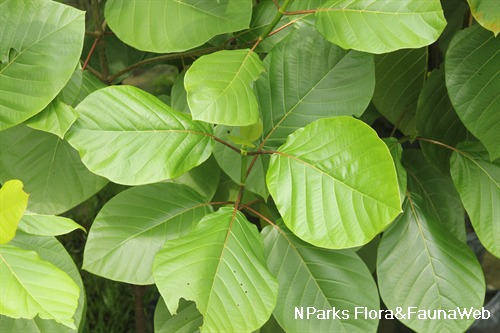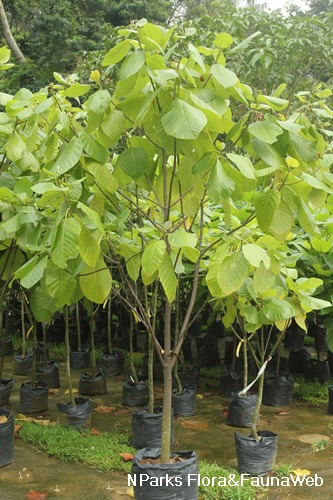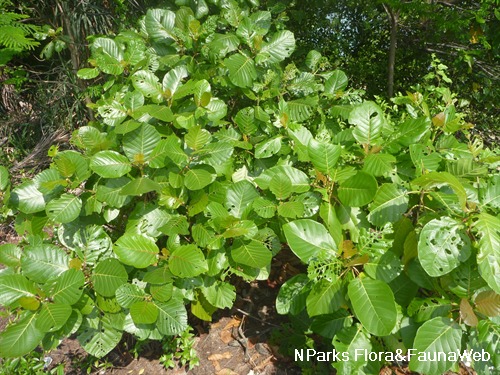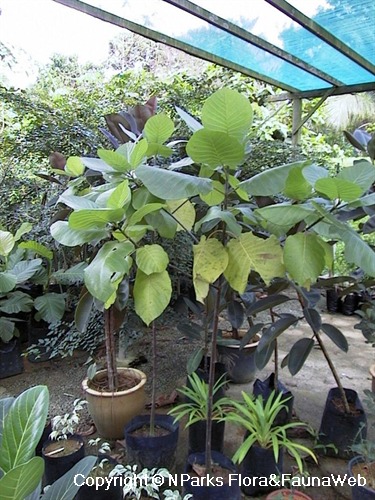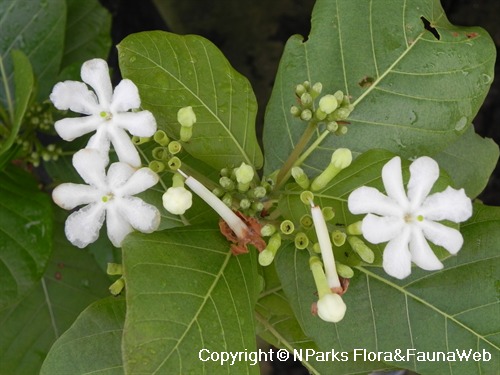
Back
Guettarda speciosa L.
| Family Name: | Rubiaceae |
| Common Name: | Sea Randa, Selar Makan, Baru-Baru Laut, Bebaru Laut, Beach Gardenia, Zebra Wood, Ketapang Pasir, 海岸桐, 榄仁舅 |
Name
Classifications and Characteristics
| Plant Division | Angiosperms (Flowering Seed Plants) (Dicotyledon) |
|---|---|
| Plant Growth Form | Tree (Medium (16m-30m), Shrubby (1m-5m), Small (6m-15m)) |
| Lifespan (in Singapore) | Perennial |
| Mode of Nutrition | Autotrophic |
| Plant Shape | Rounded |
| Maximum Height | 3 m to 22 m |
Biogeography
| Native Distribution | East Africa, tropical Asia (including Singapore), and Polynesia |
|---|---|
| Native Habitat | Terrestrial (Coastal Forest), Shoreline (Sandy Beach, Rocky Beach) |
| Preferred Climate Zone | Tropical |
| Local Conservation Status | Native to Singapore (Endangered (EN)) |
Description and Ethnobotany
| Growth Form | It is a tree up to 22 m tall. |
|---|---|
| Crown | Crown rounded and sprawling. |
| Foliage | Its opposite, stalked leaves have leaf blades that are somewhat drop-shaped, with a small tip, yellowish-green, hairless to covered with hair below, and 10–25 by 7.6–18 cm. |
| Flowers | Its flowers are white, 1.1–3.2 cm wide, with yellowish tubes that are 3.8–5 cm long, fragrant, and found in 3.8–11 cm long flowering clusters. Its flowers open about an hour after sunset and the whorl of petals drop off the next morning. |
| Fruit | Its fruits are faintly and closely ribbed, green then whitish or pinkish, and 2.2–3.2 cm across. |
| Habitat | It grows on sandy and rocky shores. It occurs locally in Pulau Semakau, Pulau Ubin, and Pulau Unum. |
| Associated Fauna | Its flowers are pollinated by insects. |
| Cultivation | It can be propagated by seed. |
| Etymology | Guettarda, commemorating the 18th century French botanist, J. E. Guettard; Latin speciosa, showy. |
| Ethnobotanical Uses | Medicinal: The bark is used to treat
chronic dysentery and can be applied to wounds when there are symptoms of inflammation,
such as the collection of pus around the damaged tissue. Timber & Products: The wood is used for building houses. Cut - Dried Flower: Its fragrant flowers are used by girls who put them in their hair for the fragrance, string them into necklaces, and used them to prepare essential oil or perfume. Others: It is cultivated as an ornamental plant. The bark is used to treat chronic dysentery and can be applied to wounds when there are symptoms of inflammation, such as the collection of pus around the damaged tissue. |
Landscaping Features
| Landscaping | It is suitable for parks and roadsides as it has fragrant flowers and can tolerate hot, sunny, windy, and frequent salt spray conditions. |
|---|---|
| Desirable Plant Features | Ornamental Flowers, Fragrant (Flowers) |
| Landscape Uses | Coastal, General, Suitable for Roadsides, Parks & Gardens, Small Gardens, Beachfront / Shoreline |
| Thematic Landscaping | Fragrant / Aromatherapy Garden |
Fauna, Pollination and Dispersal
| Pollination Method(s) | Biotic (Fauna) |
|---|---|
| Seed or Spore Dispersal | Abiotic (Water) |
Plant Care and Propagation
| Light Preference | Full Sun |
|---|---|
| Water Preference | Moderate Water |
| Plant Growth Rate | Moderate |
| Rootzone Tolerance | Drought Tolerant, Well-Drained Soils, Saline Soils / Salt Spray |
| Maintenance Requirements | Moderate |
| Propagation Method | Seed |
Foliar
| Foliage Retention | Evergreen |
|---|---|
| Mature Foliage Colour(s) | Green |
| Foliar Type | Simple / Unifoliate |
| Foliar Arrangement Along Stem | Opposite |
| Foliar Attachment to Stem | Petiolate |
| Foliar Shape(s) | Non-Palm Foliage (Obovate) |
| Foliar Venation | Pinnate / Net |
| Foliar Margin | Entire |
| Leaf Area Index (LAI) for Green Plot Ratio | 3.0 (Tree - Intermediate Canopy) |
Floral (Angiosperm)
| Flower & Plant Sexuality | Bisexual Flowers |
| Flower Colour(s) | White |
|---|---|
| Flower Grouping | Cluster / Inflorescence |
| Flower Symmetry | Radial |
| Individual Flower Shape | Tubular |
Fruit, Seed and Spore
| Mature Fruit Colour(s) | Green - Light Green, Brown |
|---|---|
| Fruit Classification | Simple Fruit |
| Fruit Type | Fleshy Fruit , Non-Accessory Fruit |
Image Repository
Others
| Master ID | 1653 |
|---|---|
| Species ID | 2946 |
| Flora Disclaimer | The information in this website has been compiled from reliable sources, such as reference works on medicinal plants. It is not a substitute for medical advice or treatment and NParks does not purport to provide any medical advice. Readers should always consult his/her physician before using or consuming a plant for medicinal purposes. |

